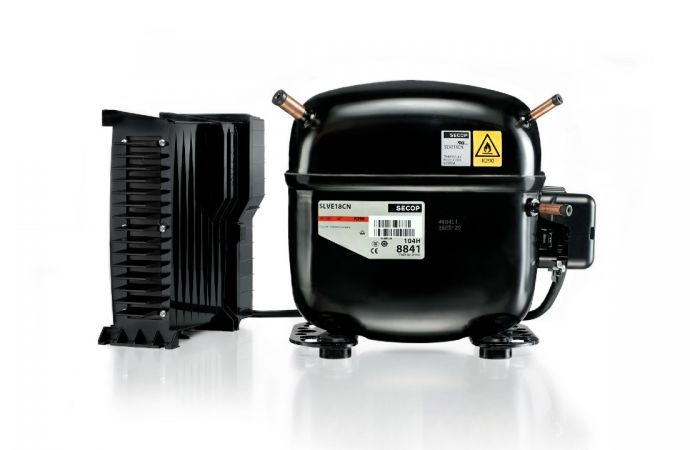Dearman’s transport refrigeration unit uses liquid nitrogen to generate both power and cooling.

Truck equipped with the Dearman transport refrigeration unit.
Using the same principles as an old-fashioned steam engine, a transportation refrigeration unit (TRU) from U.K-based Dearman Engine Company employs cryogenic liquid nitrogen as an environmentally friendly power alternative to traditional fuels as well as a coolant for the cargo.
“Dearman units have the advantage of having the same flexibility as TRUs powered by a secondary diesel engine, running fully independently of the truck and having a lower infrastructure cost than battery-electric technology,” Tony Martyn, chief technology officer for Dearman, told Accelerate Magazine.
The system works in two steps. First the extremely cold liquid nitrogen (-210°C to -196°C/-346°F to -320°F) is run through a heat exchanger where it provides two-thirds of the cooling to the temperature- controlled compartments of a trailer. (The other third is provided by a separate vapor-compression system.) Next it is sent at -20°C (-4°F) at 40 bar as a supercritical fluid through the Dearman engine (separate from the engine that drives the vehicle.)
In the Dearman engine the nitrogen mixes with warm water/glycol in direct contact. The nitrogen absorbs the heat from the water/glycol heat exchange liquid and evaporates. When changing from liquid to gas phase, nitrogen expands 710 times, and it is this expansion that is used to drive the piston in the Dearman engine and thus generate the power needed for the cooling systems, eliminating the need for traditional fuels like diesel.
After absorbing heat in the engine, the gaseous nitrogen is dispersed in the atmosphere through an exhaust valve. The heat exchange fluid is reclaimed, reheated via the vapor compression system, and reused.
The Dearman TRU is designed for a very fast temperature pull-down time. “The unit can pull down and recover much faster to set temperatures and have more precise temperature control,” said Martyn. In an 18-ton rigid truck, it can cool the trailer from 15°C (59°F) to -21°C (-5.8°F) in less than 30 minutes, the company says.
Our breakthrough in efficiency means our TRU is on track to beat diesel and battery total cost of ownership - including unit cost, maintenance cost, infrastructure cost and fuel/liquid nitrogen cost,” Tony Martyn, Dearman
Depending on the trailer’s duty cycle, a single refill of nitrogen can last up to three days, the company says. Refueling can be done by the driver, and the cost of establishing a nitrogen refueling infrastructure is “similar to a diesel refueling infrastructure,” according to Martyn.
“At a point of sufficient deployment scale - estimated to be around 20 vehicles per infrastructure - and length, the cost of the infrastructure plus the supply cost of liquid nitrogen is competitive against the cost of white diesel,” Martyn added.
The lifetime cost of the Dearman TRU is also similar to that of traditional units. “Our breakthrough in efficiency means our TRU is on track to beat diesel and battery total cost of ownership - including unit cost, maintenance cost, infrastructure cost and fuel/liquid nitrogen cost,” Martyn said.
Eliminating the need for traditional fuels to run the cooling system means the Dearman TRU emits no NOX, CO2 or particulates, only nitrogen. The CO2 savings can be up to 30 metric tons per vehicle per year. If the electricity used to manufacture the liquid nitrogen is produced with renewable energy, then up to 96% of lifecycle CO2 is saved. If the electricity is produced with traditional methods, the CO2 savings are between 30% and 85%, according to Dearman’s website.
End users and a new partner
Dearman was created in 2011 to develop the ideas of British inventor Peter Dearman. Since 2014, Dearman has received funding from the U.K. government’s Advanced Propulsion Center for the development, manufacturing and commercialization of the technology.
Unilever and British retailer Marks & Spencer are already using the Dearman TRU. Sainsbury’s, another large British retailer, tested it during development.
In August 2019, Dutch equipment provider TIP Trailer Services and Dearman announced a partnership that will enable TIP to offer its customers refrigerated trailers equipped with the Dearman TRU, as part of its 70,000- unit strong trailer fleet. TIP had successfully tested the TRU system in the Netherlands and Italy with a multi- brand food retailer.
“TIP sees its customers frequently playing with the question of how to deal with issues such as sustainability and the type of trailers to be used,” said Rogier Laan, vice president for TIP Benelux. “We therefore see it as our responsibility to be the best industry partner for these topics, and we support innovative solutions that contribute in making our industry more sustainable.”
“TIP’s support for clean technology innovation is major step to enable fleet operators to meet the increasing environmental demands upon them from regulators, foods producers and retailers," noted Khaled Simmons Dearman’s Chief Commercial Officer
Dearman TRUs can be “installed and retrofitted on trailers and medium to large rigids,” said Martyn, adding that “future versions of the Dearman system will be adapted to smaller vehicles such as vans and small rigids.”
Other existing applications of Dearman's technology include data centers, mobile pre-cooling for fresh produce, auxiliary power units for bus air conditioning and vehicle range extensions, according to Martyn.
Related stories



